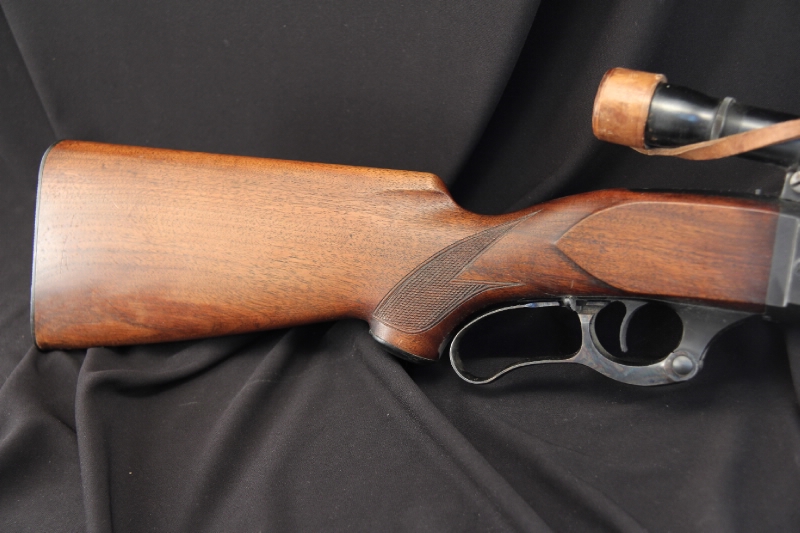
Bowlin, “RLB,” chief of the Rochester Ordnance District. The early Remington M1903 and M1903 “Modified” rifles (r.) were inspected by Col. Inspector’s cartouches are found on the left side of the stock. Bowlin, Chief of the Rochester Ordnance District. The stocks were stamped with an Ordnance Department escutcheon (“crossed cannons”) and the initials “RLB” on the left side below the magazine cut-off recess. The receiver rings of the new Remington ’03s were stamped “U.S./Remington/Model 1903/Serial No.,” and the barrels were marked “RA” (Remington Arms) in addition to the month and year of manufacture. These early production Remington M1903s were very similar to the ’03s turned out by Rock Island late in World War I, including finely finished straight-grip (“Type S”) stocks with “grasping grooves” and handguards with a prominent sight-protecting “hump.” They were well-crafted, finished in black-tinted Parkerizing and utilized the same type of heat treatment as found on late production Springfield M1903s. Interestingly, some internal Remington documents during this period refer to the rifles as “M1903 Modified.” However, the large supply of stock blanks acquired by Remington were primarily suited for fabrication of the straight-grip type of stock, so the M1903 nomenclature was not changed.

Savage arms serial number lookup full#
These were initially to have been given the “M1903A1” designation, which would have required full pistol-grip (“Type C”) stocks. Ten “trial production” M1903 rifles were produced soon after the contract was granted, and the first 1,273 production rifles were delivered in November 1941. The firm was assigned the serial number block of “3,000,000 to 3,599,999” for its initial production. By this time, Remington was ready to go into limited production of M1903s. government ordered 134,000 M1903s from Remington the same day that the British contracts were canceled. Ordnance Department immediately contracted with Remington for M1903 rifles in order to arm the rapidly expanding U.S. Model 1903A4 Sniper rifle was based on the ’03A3 as developed by Remington to save production costs in ’03 rifle manufacture. 303 rifles were no longer vitally needed, the British contracts were canceled in September 1941 before any rifles were manufactured. The British were pressing for new rifles as soon as possible, and passage of Lend-Lease legislation opened up other avenues of arms procurement. Some changes were fairly easy to accomplish, and others were more involved. 4, Mark I bayonet and modifying the grip of the stock to mimic the “hook” type pistol-grip found on the Lee-Enfield. Other changes included altering the stock (and muzzle) to allow use of the Lee-Enfield No. The British desired certain modifications, primarily related to modifications required to utilize the standard. Remington agreed to pay for the stock blanks by manufacturing cartridges for the U.S.

War Department agreed to lease Remington the somewhat worn Rock Island ’03 manufacturing equipment and provided some 600,000 walnut rifle stock “blanks” also in storage. It was suggested that the old M1903 production tooling in storage at Rock Island Arsenal be used to produce rifles for the British. Several avenues were explored, including discussions with Remington Arms Company for the production of rifles under British contract. Representatives of the British government turned to the United States for the acquisition of new arms. The disaster at Dunkirk left the British in extremely perilous straits as thousands of badly needed rifles were abandoned in France when British troops were evacuated to England. Such was the situation at the beginning of World War II. Though not used in as large numbers as the M1 Garand, Remington ’03s provided valuable service to our armed forces during World War II. Even after adoption of the M1, however, the ’03 remained the primary American service rifle until production of the Garand could meet the demand. military service rifle until the adoption of the semi-automatic M1 “Garand” rifle in 1936.


Even though large numbers of M1917 “American Enfields” were manufactured and issued during World War I to supplement the supply of M1903s, the “Springfield ’03” remained the standard U.S. The M1903 was manufactured by Springfield Armory at varying levels of production from 1903 until the late 1930s and at Rock Island Arsenal from 1903 until 1913 and again from 1917 until just after World War I. 30, Model 1903.” Known as the “Springfield,” or simply the “’03,” to several generations of American servicemen and arms enthusiasts, the M1903 has gained an enviable reputation as one of the best bolt-action military rifles of all time. military as long or as well as the famed “U.S. This article was first published in American Rifleman, November 2002.įew arms have served the U.S.


 0 kommentar(er)
0 kommentar(er)
